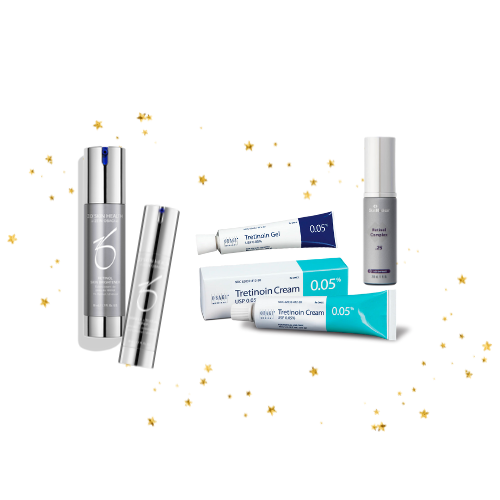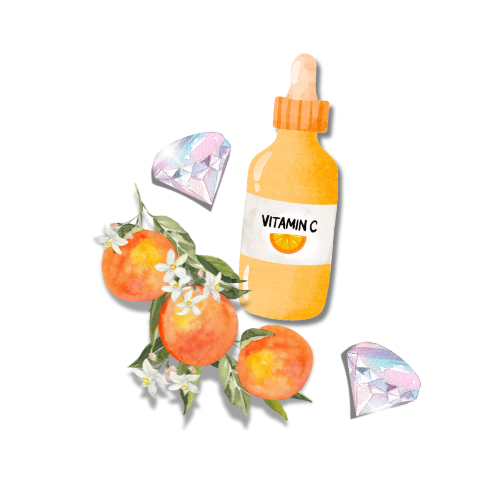a guide to navigating acne scars
Having acne is already an emotional, often traumatizing experience, but the cherry on top is when you finally think you’re past it all and can live your life without the constant awareness & anxiety of your skin, acne scars happen. They can show up in all sizes, colors & forms, in hues of white or purple or pink. But no matter how they manifest, there’s one truth: they can be a knife to your self-esteem.
If you’re like me and suffering with the aftermath of acne, I have some tips to share that I’ve gathered from my own personal research & experience on how to fade those pesky scars.
PSA: I don’t have any professional background in skincare! I’m just sharing information and my own personal experience with some of these avenues of treatment. Please do your own research if you consider any of these options and bring it up your derm/esthetician if you have one! :)
pictured: zo skin health retinol 0.1% & their wrinkle + texture repair retinol, tretinoin gel + tretinoin cream 0.05%, and skinmedica retinol 0.25% 🧴
tretinoin or retinol
Although they’re different in power, Tretinoin & Retinol both fall under the umbrella ☂️ of “retinoids.” There’s 4 you should know about —
#1. Retinyl Esters (the weakest, but least likely to irritate your skin, has to be converted into retinol —> retinal —> to reach its final form, retinoic acid, for the body to use it, over-the-counter)
#2. Retinol (has the potential to irritate you mildly/moderately depending on percentage, has to be converted into —> retinal and then to —> retinoic acid, standard percentages are 0.25%, 0.5%, and 1%)
#3. Retinaldehye (aka retinal with an a) — only has to go through 1 conversation in the body, mild/moderate irritation depending on percentage, the most potent retinoid you can get over the counter!!
#4. Retinoic acid (no conversion needed, body recognizes it immediately, likely to have an adjustment period with irritation, start low & go slow, example would be tretinoin, only available via perscription)
To learn more, Renée Rouleau explains them in-depth in a very well-versed way here <3
From personal experience, I have noticed a big change in my acne scars from the use of retinol. I use a 0.25% blend of retinol & vitamin C from my Esthetician and am planning on going up to 0.5% once i finish my bottle, but already I’ve noticed a difference! The adjustment period wasn’t bad at all, either, although it doesn’t personally manage my ongoing acne so sometimes I have to switch back to my benzoyl peroxide & clindamycin to mitigate any bumps or texture that show up. I’ve also been on Tretinoin in the past, but I was not as cautious as I should’ve been. I ended up drying up my skin and eventually giving up because I wasn’t educated on the adjustment period and the saying “start low & go slow” — I jumped straight to the 0.01% percentage… ouch.
2. azaelic acid
Azaelic acid has lots of benefits for those currently suffering with acne and those suffering from the aftermath of acne. For those in the latter group, here’s why it’s phenomenal for fighting acne scars: it encourages cell turnover (a popular theme in skincare for everything — aging, acne, etc.) and helps lighten up unwanted pigment + even out skin tone, since it is a tyrosinase inhibitor. According to research, it can take about 1-2 months to start seeing notable improvement, but this is a gentle way to get rid of unwanted hyperpigmentation without going down the more serious route of peels, retinoids, or microneedling. It’s also a great tool to fight acne while also fading leftover scars, since it is anti-bacterial & helps reduce inflammation.
3. AHAs/BHAs
Since the rise of TikTok, skincare junkies & derms alike have been throwing around the terms “AHA” and “BHA”, but what exactly do they mean and what’s the different between the two? AHA means “alpha hydroxy acid” and BHA means “beta hydroxy acid”, and from what I’ve learned, both of them are exfoliating agents, but bhas clean inside of the pores too by unclogging them. Some examples of ahas would be lactic acid, mandelic acid, and glycolic acid, while a BHA would be the infamous salicylic acid. AHAs are more moisturizing 💧 while BHAs are known to dry you out a little more 🌵. In short, BHAs are usually recommended for those suffering with acne & texture, while AHAs are recommended to those with dry, sensitive, or aging skin. But since they’re both exfoliating agents, they help skin turnover and therefore reduce the appearance of acne scars. A little trick I once heard was to associate BHA with “below the skin” and AHA with “above the skin" when thinking about their power & roles.
4. Microneedling
This option may sound a little scary, and if you’ve seen before & after pictures of microneedling, you know it can look scary too. I thought so too, until I read about it, learned the amazing science behind it, and did three rounds myself. Microneedling is a procedure that involves using tiny, sterile needles (say no to at-home microneedling!!!) to puncture the skin and superficially wound it to promote collagen & elastin production. What does this mean, you ask? This means your skin’s healing process is stimulated, firming & smoothing your skin. BUT! If you’re currently suffering from acne, you may not be a candidate for this, depending on your estie’s opinion, because the needles can spread the active bacteria and worsen the condition. This is an intense & expensive route to take to address scarring, so talk to your dermatologist/esthetician and do your own research! I’ve had a dermatologist talk me into trying out something that left me with hyperpigmentation for years afterwards, so always trust your gut and don’t let yourself get talked into doing anything you don’t feel comfortable doing.
MY EXPERIENCE: 6/10 - relieved minimal scarring but not completely, but only did 3 rounds and up to 8 can be recommended for serious scarring - but not painful, just made me incredibly dry and felt a little like a sunburn!
5. chemical peels
I’ve gotten several chemical peels before, and personally, I don’t enjoy them since I have to stop my acne skincare routine while my skin peels (which in turn can create more acne sometimes), but it’s a great option overall for acne scarring/hyperpigmentation. However, it’s not the best if you’re the type to be embarrassed to be walking around with your skin peeling off, but other than that, it’s a great way to speed up the process of revealing brand new skin. The only caveat is if you’re prone to picking at your skin, you ABSOLUTELY CAN’T peel it! This can lead to more hyperpigmentation/hypopigmentation or scarring. It can also be slightly uncomfortable when being applied, but other than that, it’s a very effective way to beginning the process of correcting any unwanted discoloration.
6. vitamin c
Vitamin C, a holy grail antioxidant, is known for its brightening properties and ability to stimulate collagen. An important thing to note with this ingredient, though, is that it works best on hypertrophic scars, which are likely what you imagine when you picture a scar in your mind’s eye. This means that atropic scars, like the deeper, irregularly textured ones, like boxcar or icepick scars, are unlikely to be positively changed with vitamin C — I think, based on my research. However, for pesky post-inflammatory hyperpigmentation, it’s a winner! Its healing, anti-inflammatory properties are perfect for reducing sebum production and minimizing the pigment leftover from breakouts.
7. dermaplaning
This is a less invasive tactic and less likely to magically cure anything, but a good method to add to the list nonetheless. If you haven’t heard of it, dermaplaning is the act of shaving your face with a hand-held blade, revealing freshly exfoliated & baby smooth skin in its wake. It removes dirt, debris and dead skin cells, and the theory behind it helping with acne scars stems from experts claiming it skims the surface layers of skin off to eventually (with time) help create a more smooth, even surface. For bumpy scars or crater-like scars alike, this could be helpful. There’s debates within the skincare community on whether or not you should do this at-home or in a clinic, but nevertheless, drugstores or beauty stores sell packs of these razors for cheap. As long as you’re careful and use the right methods (watch videos and do your research, otherwise you could cut yourself or introduce new bacteria, causing more breakouts!), you should be fine.





